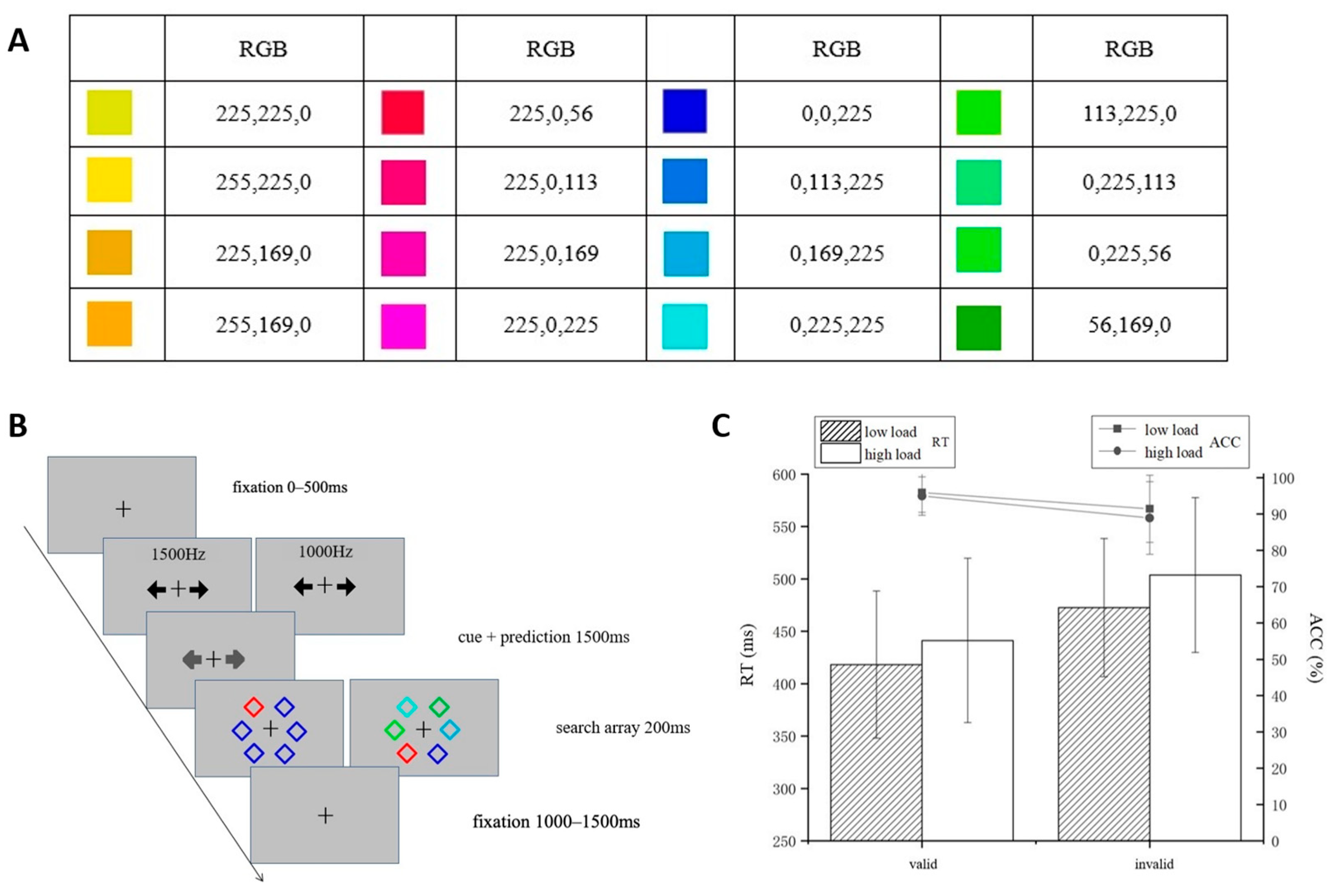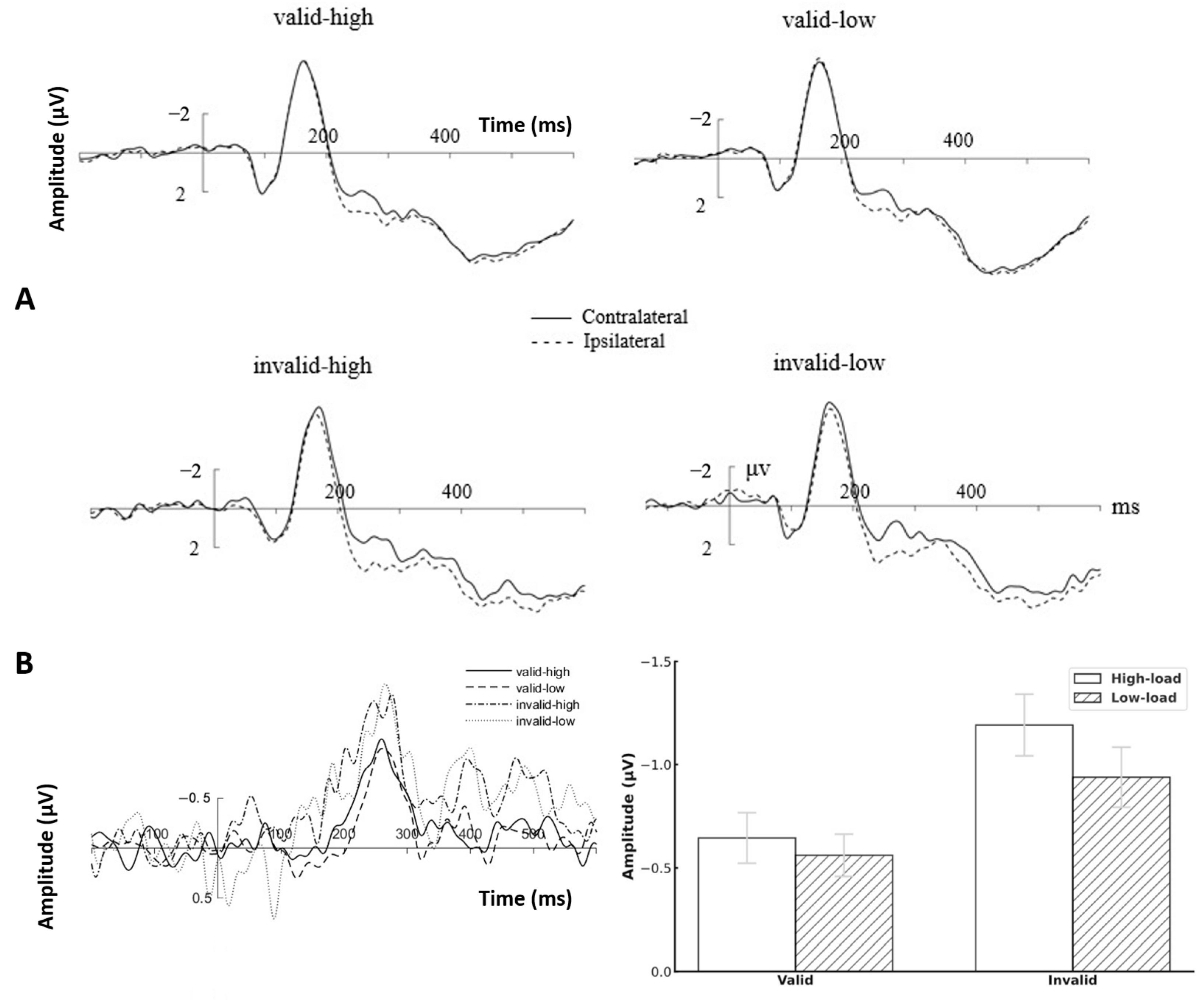The Effect and Time Course of Prediction and Perceptual Load on Category-Based Attentional Orienting Across Color and Shape Dimensions
Abstract
1. Introduction
2. Experiment 1
2.1. Method
2.1.1. Participants
2.1.2. Design and Procedure
2.1.3. ERP Recording and Analysis
2.2. Results
2.2.1. Behavioral Data
2.2.2. ERP Data
3. Experiment 2
3.1. Method
3.1.1. Participants
3.1.2. Design and Procedure
3.2. Results
3.2.1. Behavioral Data
3.2.2. ERP Data
4. Overall Comparison
5. Discussion
6. Conclusions
Author Contributions
Funding
Institutional Review Board Statement
Informed Consent Statement
Data Availability Statement
Conflicts of Interest
References
- Posner, M.I.; Rothbart, M.K.; Ghassemzadeh, H. Restoring Attention Networks. Yale J. Biol. Med. 2019, 92, 139–143. [Google Scholar]
- Do Carmo Blanco, N.; Allen, J.J.B. Guidance of Spatial Attention during Associative Learning: Contributions of Predictability and Intention to Learn. Psychophysiology 2018, 55, e13077. [Google Scholar] [CrossRef]
- Jenkins, M.; Grubert, A.; Eimer, M. Category-Based Attentional Guidance Can Operate in Parallel for Multiple Target Objects. Biol. Psychol. 2018, 135, 211–219. [Google Scholar] [CrossRef]
- Levin, D.T.; Takarae, Y.; Miner, A.G.; Keil, F. Efficient Visual Search by Category: Specifying the Features That Mark the Difference between Artifacts and Animals in Preattentive Vision. Percept. Psychophys. 2001, 63, 676–697. [Google Scholar] [CrossRef]
- Lim, Y.I.; Clement, A.; Pratt, J. Typicality Modulates Attentional Capture by Object Categories. Atten. Percept. Psychophys. 2021, 83, 1397–1406. [Google Scholar] [CrossRef]
- Nako, R.; Grubert, A.; Eimer, M. Category-Based Guidance of Spatial Attention during Visual Search for Feature Conjunctions. J. Exp. Psychol. Hum. Percept. Perform. 2016, 42, 1571–1586. [Google Scholar] [CrossRef]
- Wu, X.; Wang, X.; Saab, R.; Jiang, Y. Category-based Attentional Capture Can Be Influenced by Color- and Shape-dimensions Independently in the Conjunction Search Task. Psychophysiology 2020, 57, e13526. [Google Scholar] [CrossRef]
- Olivers, C.N.L.; Peters, J.; Houtkamp, R.; Roelfsema, P.R. Different States in Visual Working Memory: When It Guides Attention and When It Does Not. Trends Cogn. Sci. 2011, 15, 327–334. [Google Scholar] [CrossRef]
- Fan, J. An Information Theory Account of Cognitive Control. Front. Hum. Neurosci. 2014, 8, 680. [Google Scholar] [CrossRef]
- Summerfield, C.; Egner, T. Expectation (and Attention) in Visual Cognition. Trends Cogn. Sci. 2009, 13, 403–409. [Google Scholar] [CrossRef]
- Beck, D.M.; Lavie, N. Look Here but Ignore What You See: Effects of Distractors at Fixation. J. Exp. Psychol. Hum. Percept. Perform. 2005, 31, 592–607. [Google Scholar] [CrossRef]
- Aitken, F.; Turner, G.; Kok, P. Prior Expectations of Motion Direction Modulate Early Sensory Processing. J. Neurosci. 2020, 40, 6389–6397. [Google Scholar] [CrossRef]
- Mumford, D. On the Computational Architecture of the Neocortex—II The Role of Cortico-Cortical Loops. Biol. Cybern. 1992, 66, 241–251. [Google Scholar] [CrossRef] [PubMed]
- Bonato, M.; Lisi, M.; Pegoraro, S.; Pourtois, G. Cue-Target Contingencies Modulate Voluntary Orienting of Spatial Attention: Dissociable Effects for Speed and Accuracy. Psychol. Res. 2018, 82, 272–283. [Google Scholar] [CrossRef]
- Kok, P.; Jehee, J.F.M.; de Lange, F.P. Less Is More: Expectation Sharpens Representations in the Primary Visual Cortex. Neuron 2012, 75, 265–270. [Google Scholar] [CrossRef]
- Esterman, M.; Yantis, S. Perceptual Expectation Evokes Category-Selective Cortical Activity. Cereb. Cortex 2010, 20, 1245–1253. [Google Scholar] [CrossRef]
- Lavie, N.; Cox, S. On the Efficiency of Visual Selective Attention: Efficient Visual Search Leads to Inefficient Distractor Rejection. Psychol. Sci. 1997, 8, 395–396. [Google Scholar] [CrossRef]
- Lavie, N.; Fox, E. The Role of Perceptual Load in Negative Priming. J. Exp. Psychol. Hum. Percept. Perform. 2000, 26, 1038–1052. [Google Scholar] [CrossRef]
- Yang, H.; Zelinsky, G.J. Visual Search Is Guided to Categorically-Defined Targets. Vis. Res. 2009, 49, 2095–2103. [Google Scholar] [CrossRef]
- Katsuki, F.; Constantinidis, C. Bottom-up and Top-down Attention: Different Processes and Overlapping Neural Systems. Neuroscientist 2014, 20, 509–521. [Google Scholar] [CrossRef]
- Pinto, Y.; van der Leij, A.R.; Sligte, I.G.; Lamme, V.A.F.; Scholte, H.S. Bottom-up and Top-down Attention Are Independent. J. Vis. 2013, 13, 16. [Google Scholar] [CrossRef]
- Memelink, J.; Hommel, B. Intentional Weighting: A Basic Principle in Cognitive Control. Psychol. Res. 2013, 77, 249–259. [Google Scholar] [CrossRef]
- Lamy, D.; Leber, A.; Egeth, H.E. Effects of Task Relevance and Stimulus-Driven Salience in Feature-Search Mode. J. Exp. Psychol. Hum. Percept. Perform. 2004, 30, 1019–1031. [Google Scholar] [CrossRef]
- Folk, C.L.; Leber, A.B.; Egeth, H.E. Made You Blink! Contingent Attentional Capture Produces a Spatial Blink. Percept. Psychophys. 2002, 64, 741–753. [Google Scholar] [CrossRef]
- Eimer, M.; Grubert, A. The Gradual Emergence of Spatially Selective Target Processing in Visual Search: From Feature-Specific to Object-Based Attentional Control. J. Exp. Psychol. Hum. Percept. Perform. 2014, 40, 1819–1831. [Google Scholar] [CrossRef]
- Wu, X.; Wang, J.; Wang, Y.; Chen, Y.; Yang, H. The Processing Mechanism of Category-Specific Attentional Control Settings in Attentional Capture. Adv. Psychol. Sci. 2022, 30, 2219–2227. [Google Scholar] [CrossRef]
- Berggren, N.; Eimer, M. Spatial Filtering Restricts the Attentional Window during Both Singleton and Feature-Based Visual Search. Atten. Percept. Psychophys. 2020, 82, 2360–2378. [Google Scholar] [CrossRef]
- Mangun, G.R.; Buonocore, M.H.; Girelli, M.; Jha, A.P. ERP and fMRI Measures of Visual Spatial Selective Attention. Hum. Brain Mapp. 1998, 6, 383–389. [Google Scholar] [CrossRef]
- Jolicœur, P.; Brisson, B.; Robitaille, N. Dissociation of the N2pc and Sustained Posterior Contralateral Negativity in a Choice Response Task. Brain Res. 2008, 1215, 160–172. [Google Scholar] [CrossRef]
- Luck, S.J.; Hillyard, S.A. Spatial Filtering during Visual Search: Evidence from Human Electrophysiology. J. Exp. Psychol. Hum. Percept. Perform. 1994, 20, 1000–1014. [Google Scholar] [CrossRef]
- Faul, F.; Erdfelder, E.; Buchner, A.; Lang, A.-G. Statistical Power Analyses Using G*Power 3.1: Tests for Correlation and Regression Analyses. Behav. Res. Methods 2009, 41, 1149–1160. [Google Scholar] [CrossRef]
- Delorme, A.; Makeig, S. EEGLAB: An Open Source Toolbox for Analysis of Single-Trial EEG Dynamics Including Independent Component Analysis. J. Neurosci. Methods 2004, 134, 9–21. [Google Scholar] [CrossRef]
- Summerfield, C.; Koechlin, E. A Neural Representation of Prior Information during Perceptual Inference. Neuron 2008, 59, 336–347. [Google Scholar] [CrossRef]
- Kóbor, A.; Kardos, Z.; Horváth, K.; Janacsek, K.; Takács, Á.; Csépe, V.; Nemeth, D. Implicit Anticipation of Probabilistic Regularities: Larger CNV Emerges for Unpredictable Events. Neuropsychologia 2021, 156, 107826. [Google Scholar] [CrossRef]
- Puri, A.M.; Wojciulik, E. Expectation Both Helps and Hinders Object Perception. Vis. Res. 2008, 48, 589–597. [Google Scholar] [CrossRef]
- Brewer, A.A.; Liu, J.; Wade, A.R.; Wandell, B.A. Visual Field Maps and Stimulus Selectivity in Human Ventral Occipital Cortex. Nat. Neurosci. 2005, 8, 1102–1109. [Google Scholar] [CrossRef]
- Stanislav, K.; Rogachev, A. Ventral Visual Cortex Areas and Processing of Color and Shape in Visual Working Memory. Int. J. Psychophysiol. 2021, 168, S155–S156. [Google Scholar] [CrossRef]
- Theeuwes, J. Perceptual Selectivity for Color and Form. Percept. Psychophys. 1992, 51, 599–606. [Google Scholar] [CrossRef]
- Eimer, M. The N2pc Component as an Indicator of Attentional Selectivity. Electroencephalogr. Clin. Neurophysiol. 1996, 99, 225–234. [Google Scholar] [CrossRef]
- Theeuwes, J.; Atchley, P.; Kramer, A.F. On the Time Course of Top-Down and Bottom-Up Control of Visual Attention; The MIT Press: Cambridge, MA, USA, 2000; Volume XVIII, ISBN 0262133679. [Google Scholar]
- Robbins, A.; Hout, M.C. Categorical Target Templates: Typical Category Members Are Found and Identified Quickly during Word-Cued Search. Vis. Cogn. 2015, 23, 817–821. [Google Scholar] [CrossRef]
- Churchland, M.M.; Yu, B.M.; Ryu, S.I.; Santhanam, G.; Shenoy, K. V Neural Variability in Premotor Cortex Provides a Signature of Motor Preparation. J. Neurosci. 2006, 26, 3697–3712. [Google Scholar] [CrossRef]




Disclaimer/Publisher’s Note: The statements, opinions and data contained in all publications are solely those of the individual author(s) and contributor(s) and not of MDPI and/or the editor(s). MDPI and/or the editor(s) disclaim responsibility for any injury to people or property resulting from any ideas, methods, instructions or products referred to in the content. |
© 2025 by the authors. Licensee MDPI, Basel, Switzerland. This article is an open access article distributed under the terms and conditions of the Creative Commons Attribution (CC BY) license (https://creativecommons.org/licenses/by/4.0/).
Share and Cite
Jiang, Y.; Chen, T.; Ou, F.; Wang, Y.; Feng, R.; Wu, X.; Lin, L. The Effect and Time Course of Prediction and Perceptual Load on Category-Based Attentional Orienting Across Color and Shape Dimensions. Brain Sci. 2025, 15, 1210. https://doi.org/10.3390/brainsci15111210
Jiang Y, Chen T, Ou F, Wang Y, Feng R, Wu X, Lin L. The Effect and Time Course of Prediction and Perceptual Load on Category-Based Attentional Orienting Across Color and Shape Dimensions. Brain Sciences. 2025; 15(11):1210. https://doi.org/10.3390/brainsci15111210
Chicago/Turabian StyleJiang, Yunpeng, Tianyu Chen, Fangyuan Ou, Yun Wang, Ruixi Feng, Xia Wu, and Lin Lin. 2025. "The Effect and Time Course of Prediction and Perceptual Load on Category-Based Attentional Orienting Across Color and Shape Dimensions" Brain Sciences 15, no. 11: 1210. https://doi.org/10.3390/brainsci15111210
APA StyleJiang, Y., Chen, T., Ou, F., Wang, Y., Feng, R., Wu, X., & Lin, L. (2025). The Effect and Time Course of Prediction and Perceptual Load on Category-Based Attentional Orienting Across Color and Shape Dimensions. Brain Sciences, 15(11), 1210. https://doi.org/10.3390/brainsci15111210






